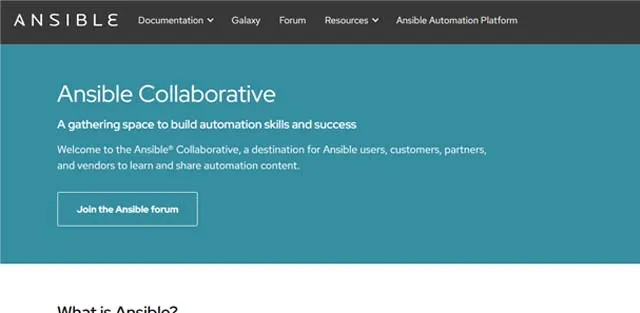
The Ansible Automation Platform by Red Hat is a robust solution that automates IT processes like system setup, application deployment, and policy management. Fresh details from the Red Hat site showcase its new self-managed deployment on Microsoft Azure, offering enhanced flexibility for cloud users. It also includes an updated Ansible Basics course (DO007) with free video lessons to guide newcomers in mastering automation. This tool stands out for its scalability and strong security, serving IT crews globally.
- Red Hat Ansible Boosts Business Efficiency with Automation
- AnsibleFest at Red Hat Summit 2025 Opens Registration in Boston
- Red Hat AnsibleFest 2025: Unlock Automation Skills at Red Hat Summit
- Red Hat Ansible Automation Platform Simplifies IT Operations for Enterprises
- Red Hat Ansible Automation Platform Showcases AI-Driven Innovation at Summit ...
- AnsibleFest 2025 Highlights Automation’s Role in AI-Driven IT
- Red Hat and NVIDIA Power Agentic AI with Enterprise AI Factory Integration
- AnsibleFest 2025 Showcases AI-Driven Automation Innovations
- Ansible Automation Platform Unveils AI and Terraform Enhancements
- Ensono Boosts Efficiency with Ansible Automation Platform
- Ansible Automation Platform Enhances AI-Driven IT Efficiency
- Red Hat Unveils Ansible Lightspeed AI Chatbot for Automation
What is Ansible Automation Platform?
The Ansible Automation Platform, created by Red Hat, is an advanced tool for automating IT tasks such as system setup, software deployment, and policy management. It’s designed for IT professionals and businesses seeking to save time and increase productivity. Built on the foundation of the open-source Ansible project, it enhances security, scalability, and support for handling intricate IT systems. As interest grows in areas like Ansible Automation Platform pricing, Red Hat’s automation tools, and tool comparisons such as Ansible vs Jenkins or Ansible vs Terraform, it's clear that organizations are actively exploring the best solutions to streamline their IT processes.
Features: Key Features and Their Benefits
Ansible Automation Platform offers a range of capabilities that make IT automation simple and efficient. Here are the highlights:
- Policy as Code Automation: Automatically enforces rules and standards across systems, a boon for those looking to automate policy as code with Ansible.
- Event-Driven Automation: Reacts instantly to changes using Event-Driven Ansible, cutting down on manual tasks.
- Scalability: Handles small projects or vast networks effortlessly, perfect for Ansible Automation Platform for enterprise needs.
- Simple Playbooks: Lets users automate tasks with easy scripts, no deep coding required—ideal for writing first Ansible playbook.
- Robust Security: Provides a secure, enterprise-level setup, addressing Ansible Automation security priorities.
These tools help teams work faster, avoid mistakes, and focus on their core goals.
Use Cases: Real-World Examples
Ansible Automation Platform proves its worth in everyday situations. Here are a few ways it’s used:
- Server Setup: Businesses turn to Ansible Automation for servers to configure numerous servers quickly and uniformly.
- Software Rollouts: Teams use Ansible for application deployment to update applications across cloud systems without hassle.
- Rule Enforcement: IT staff rely on Ansible Policy as Code to automate checks, ensuring systems meet required standards.
These examples demonstrate how Ansible tackles common IT hurdles, making it a trusted automation option. In many real-world setups, Jenkins handles CI/CD tasks, while Ansible takes care of infrastructure automation, making the comparison less about choosing one over the other and more about how they can work together.
Implementation: How to Get Started
Getting going with Ansible Automation Platform is easy and approachable:
- Check the Guides: Head to Red Hat Ansible documentation for step-by-step instructions and resources.
- Test It Out: Begin with the Ansible Automation Platform trial to try it free and see its potential.
- Write a Playbook: Use create Ansible playbook to automate a basic job, like adding software.
- Expand Usage: Apply Ansible enterprise solutions to integrate it fully into your operations.
You don’t need expert skills—just a desire to make IT tasks smoother.
Ansible vs Jenkins vs Terraform: Key Tool Comparison Unveiled
| Feature / Purpose | Ansible | Jenkins | Terraform |
|---|---|---|---|
| Primary Use Case | IT automation, configuration management | CI/CD pipeline automation | Infrastructure as Code (IaC) |
| Best For | Automating server setup, app deployment, policies | Building, testing, and deploying software | Provisioning and managing cloud infrastructure |
| Language / Syntax | YAML (Playbooks) | Groovy (Scripted Pipelines), Declarative Pipelines, UI-based jobs | HCL (HashiCorp Configuration Language) |
| Agent Requirement | Agentless (SSH-based) | Optional agents for distributed builds; single-node setups possible | Agentless (uses APIs) |
| Execution Type | Push-based (runs from control node) | Event-driven (CI/CD triggered, e.g., by Git commits or schedules) | Declarative (plans and applies infrastructure) |
| Typical Integration | With Jenkins, Terraform, cloud platforms | With Git, Ansible, Docker, Kubernetes | With Ansible, CI/CD tools, cloud providers |
| Learning Curve | Low to medium (YAML is simple) | Medium (Groovy/declarative pipelines, plugin management) | Medium to high (HCL and infrastructure logic) |
| Best Used By | Sysadmins, DevOps, IT teams | Developers, DevOps teams | Cloud engineers, DevOps teams |
| State Management | No built-in state management | No state management | Maintains state of infrastructure |
| Open Source / Enterprise | Open source + Red Hat Ansible Automation Platform | Open source + CloudBees CI (enterprise) | Open source + Terraform Cloud/Enterprise |
Pros and Cons
Pros:
- User-friendly, even for those exploring Ansible for beginners.
- Cuts down time and human errors.
- Adapts to any scale with Ansible scalability.
- Backed by a helpful community and solid enterprise support.
- Can integrate seamlessly with tools like Jenkins, easing the Ansible vs Jenkins dilemma by enabling hybrid workflows.
Cons:
- Setting it up might take effort for larger systems.
- Full features come with a cost, as noted in Ansible Automation Platform pricing.
- Lacks a strong visual interface for some users.
Start Automating with Ansible Today
Ready to streamline your IT workflows? Get started with Ansible Automation Platform today and discover how simple, scalable, and secure automation can be.
 Ansible pricing 2025: Plans, Features, and Subscription Costs Explained
Ansible pricing 2025: Plans, Features, and Subscription Costs Explained
- Price
- Contact
 Ansible Reviews & Ratings: See What Users and Experts Are Saying
Ansible Reviews & Ratings: See What Users and Experts Are Saying
 Ansible FAQ: Learn How to Use It, Troubleshoot Issues, and More
Ansible FAQ: Learn How to Use It, Troubleshoot Issues, and More
On most Linux distributions, Ansible can be installed using the system's package tools. For Ubuntu-based systems, use apt. The process takes just a few commands and doesn’t require installing any software on the target machines, which makes Ansible one of the easiest tools to begin with in the automation space.
Ansible uses a format called a playbook—written in YAML—to describe steps like installing software, editing config files, or managing services. A minimal example might involve naming your server group, specifying privileges, and listing what should be installed or configured. The beauty is that these steps are human-readable and version-controlled like code.
Ad-hoc commands in Ansible are ideal when you need to perform a quick task—such as installing a single package or restarting a service—without crafting a full automation script. These one-liners are efficient for troubleshooting or patching, especially when managing multiple servers at once.
In larger projects, grouping your automation tasks into roles makes everything more maintainable. Think of a role like a self-contained folder for one purpose—such as managing a database or configuring firewalls. Each role keeps related tasks, files, and variables together, so you can reuse them across environments and teams.
Ansible keeps track of all systems it manages using an inventory file. This file lists hostnames or IP addresses and lets you group them under labels like web or staging. It’s flexible—you can define hosts manually or pull them from cloud services dynamically. Once that’s in place, Ansible targets those machines for any commands or playbooks you run.
 Summary
Summary
The Ansible Automation Platform transforms how IT teams and companies manage tasks, enforce rules, and improve performance. Its straightforward playbooks and ability to grow with your needs make it a standout choice. Whether you’re researching best IT automation tools or curious about how Ansible works, this platform offers real benefits. Ready to make IT easier? Take the first step today—try the free trial or visit redhat.com for more details.














